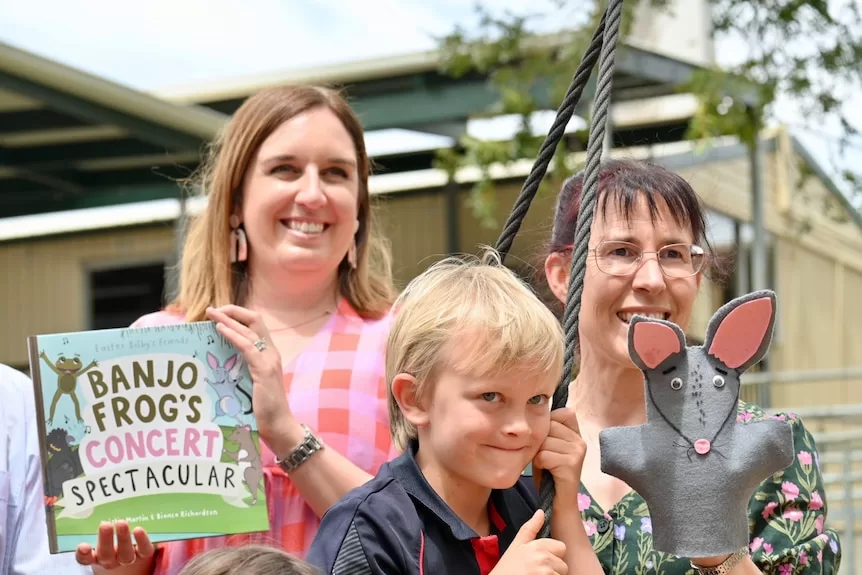- In short: A new book about rabbit control aims to reach landholders via their children.
- Rabbit-Free Australia says people are becoming complacent about the issue.
- What’s next: A series of picture books is planned to feature different parts of the country.
An author hopes her new book will help very young children understand why Australia’s cute but ultimately destructive wild rabbits need to be controlled.
Children’s poet and teacher, Kristin Martin, said she was approached by publisher Michael Bollen with a concept that was sponsored by the Foundation for Rabbit-Free Australia.
The research group wanted to educate children in their first years of school about the damage done by rabbits, how they affected native animals and how they could be managed.
But Mrs Martin said finding the right wording proved to be a project in itself.
“I did a trial read to a few year-one students and a student got upset,” she said.
The final version was locked in after a lot of back and forth between Mrs Martin, Mount Gambier-based illustrator Bianca Richardson, the publishers and the foundation.
”We can’t even use the words ‘Get rid of the rabbits’,” she told her collaborators.
“It’s a children’s book.
So, I said ‘We [need to] ask the adults to remove the rabbits [in the story] and we don’t need to go there because that’s for adults. That’s not for children’.”
The book, Banjo Frog’s Concert Spectacular, was launched last week.
The community of Rapid Bay, near the tip of the Fleurieu Peninsula south of Adelaide, and its small 36-student school were chosen as the backdrop for the story because of the damage an increasing number of rabbits were doing in the area.
It tells the story of the Easter bilby’s visit to town to watch Banjo Frog’s Concert Spectacular.
He arrives to find all the animals too tired and hungry to perform because the wild rabbits have eaten their habitats and food.
He and the animals then go to the school and suggest the children write a letter to their parents, asking them to remove the wild rabbits and plant native trees, shrubs and grasses.
The book ends with the “bonk bonk” sounds of the banjo frog as the concert goes ahead amid newly planted seedlings.
Rabbit-Free Australia
Foundation for Rabbit-Free Australia chairman Wayne Meyer said the book was the first in a planned series, each to be set in a different area around Australia featuring local wildlife and vegetation impacted by the presence of the rabbits.
The foundation has sponsored research into controlling rabbit numbers since being established in the 1990s to support the release of the calicivirus.
It also lobbied lobbying for the appointment of a national rabbit control coordinator, similar to the existing National Feral Cat and Fox Management Coordinator.
Professor Meyer said there was a lack of understanding among many landowners, particularly newer ones, about the need to continue to control rabbit numbers.
“No one living today remembers what the landscape was like before rabbits,” he said.
“People get complacent, they say, ‘Oh well, they’re here now’.”
The foundation estimates there are about 200 million wild European rabbits across about 70 per cent of the Australian continent.
The species thrives in areas with hot dry summers and cool winters but not in more tropical areas and were first introduced, likely in more than one incidence, in the 1800s.
Professor Meyer said there had been a growing awareness amongst ecologists it wasn’t enough just to remove predators when trying to reintroduce native species to an area.
He said rabbits had to be removed as well so food and habitat were sustained.
He said he hoped the book would have a long-lasting impact as the children took their message into adulthood.
He also hoped they would talk to their parents about the world around them and what they had learned at school.
“Children are a very big influence on how parents think and perceive things,” he said.
Laced carrots in use
The Fleurieu and Hills Landscape Board, which holds regular rabbit management days across the region, said European rabbits had changed ecosystems by eating native plants relied on by native animals.
It said there had been an “unprecedented surge” in rabbit numbers this year due to the moist summer conditions.
Pests and land team leader Susan Ivory, who spoke recently on ABC Radio Adelaide, said rabbits caused a problem for people doing revegetation work as they targeted the newly growing plants.
The board provided provide pindone-laced carrots to residents during February and March when food sources were scarce and rabbits would more likely eat them.
Pindone is an anticoagulant which works in a similar way to some rat and mice baits.
The board has also been working with the region’s six local councils to release RHDV K5 Calicivirus-innnoculated carrots at strategic sites.
Get our local newsletter, delivered free each Friday
